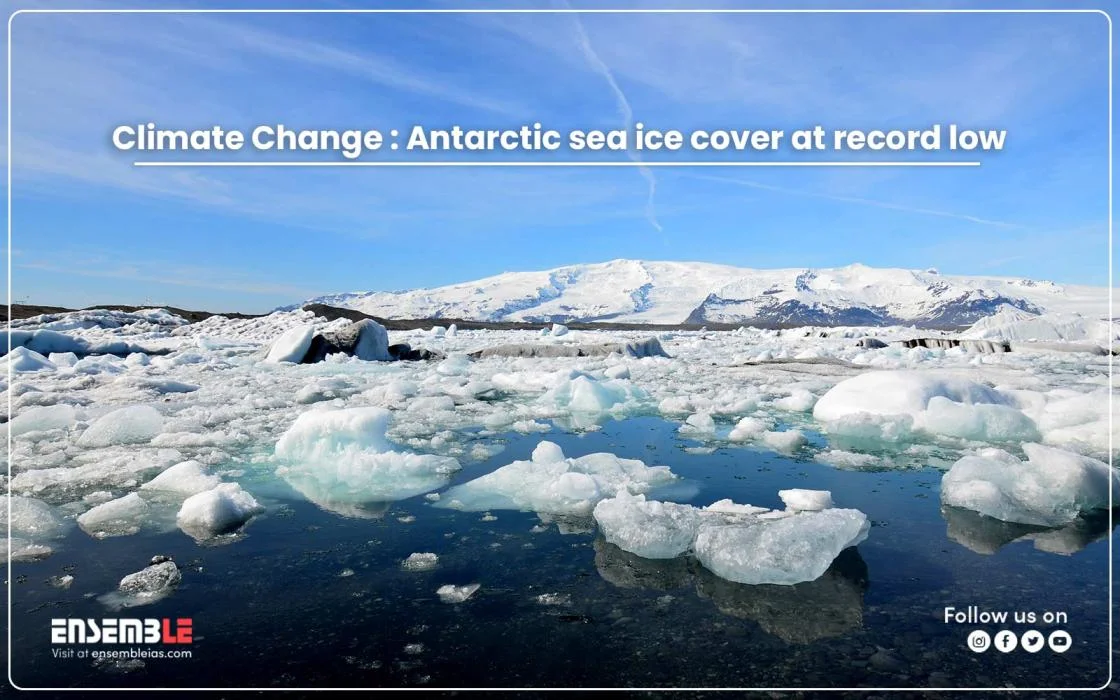It is indeed worrisome that rapid Climate Change is having serious consequences for the environment. Soil Erosion, Deforestation, Ozone Layer Depletion, and many more environment-related issues should be alarming bells for society. However, the Melting of Ice cover in Antarctica is also one among several other environmental-related issues which should be worrisome for society as a whole.
What’s the Context?
As per the scientific data, the Antarctic ice cover, in the past 6 years, has witnessed major declines. On 21st February, the extent of sea ice cover fell to the lowest level ever recorded. This is in continuation of the growing worrisome trend where the rise in global temperatures has led to the shrinking of sea ice covers.
What does the Shrinking of Ice Cover in the Antarctic mean?
- ● The shrinking of ice cover in Antarctica refers to the reduction in the extent and thickness of ice across the continent of Antarctica.
- ● This shrinking can occur in various forms, including the melting of ice shelves, the retreat of glaciers, and the thinning of sea ice.
Ice shelves are large floating platforms of ice that extend from the coast out over the ocean. When these ice shelves melt or break apart, they contribute to the shrinking of the ice cover. Similarly, glaciers on the Antarctic mainland can also retreat and lose mass, leading to a reduction in the overall ice cover.
Sea ice, which forms when seawater freezes, also plays a role in the ice cover of Antarctica. The extent of sea ice around Antarctica can vary seasonally, with a maximum extent during the winter months. However, in recent years, there has been a decline in the extent and thickness of sea ice in some areas, contributing to the shrinking of the ice cover.
The Worrisome Trends (Data & Statistics)
The shrinking of glaciers and ice cover is not new in Antarctica. However, in the recent few years the trend has reached a record low, eventually leading to a rise in Sea level which poses a major threat to numerous nations, particularly coastal countries.
- ● According to NASA, meltwater from Antarctic ice accounts for about 1/3rd of the the global average rise in sea level since 1993.
- ● The sea ice extent on all other days of this current year, leaving aside the month of March and April, remained the lowest year recorded.
- ● The Sea ice around Antarctica was recorded at its lowest extent on 21st Feb 2023. It was recorded at 1.79 million square kilometers.
- ● This marked the 2nd time that scientists and observers observed the ice shrinking below the worrisome figure of 2 million square kilometers.
Causes behind the Sea Ice Cover in the Antarctic hitting all-time low
- ● Rising global temperatures: Increasing greenhouse gas emissions contribute to global warming, leading to higher temperatures that can accelerate the melting of sea ice in Antarctica.
- ● Changing wind patterns: Alterations in atmospheric circulation patterns can affect the formation and movement of sea ice, potentially reducing its extent and thickness.
- ● Oceanic changes: Warming ocean waters can melt sea ice from beneath, weakening its stability and causing it to break up more easily.
- ● Natural climate variability: Natural climate phenomena like El Niño events can temporarily influence the climate in the Southern Ocean and contribute to reductions in sea ice cover.
The Effects of Shrinking of Ice Cover in the Antarctic
- ● Rising sea levels: The melting of ice shelves and glaciers in Antarctica contributes to the overall rise in global sea levels, which poses risks to coastal communities and ecosystems worldwide.
- ● Ecosystem disruption: Changes in ice cover can impact the habitats of various organisms, including penguins, seals, and krill, which form the base of the Antarctic food web. This disruption can have cascading effects on the entire ecosystem.
- ● Albedo feedback: Reduced ice cover decreases the reflectivity of the Earth's surface, leading to increased absorption of solar radiation and further warming.
- ● Ocean circulation patterns: Changes in ice cover can influence oceanic currents and circulation, potentially altering global climate patterns.
Conclusion
The Arctic sea ice extent in February 2023 was slightly higher compared to the record lows observed in 2016 and 2017, measuring 4% below the monthly average. The Copernicus organization reported that February 2023 ranked as the fifth warmest globally, with Europe, the U.S. East, northern Russia, Pakistan, and India experiencing above-average temperatures. Conversely, the U.S. West, northeastern Russia, Turkey, and northern Australia had a colder February compared to previous years.




